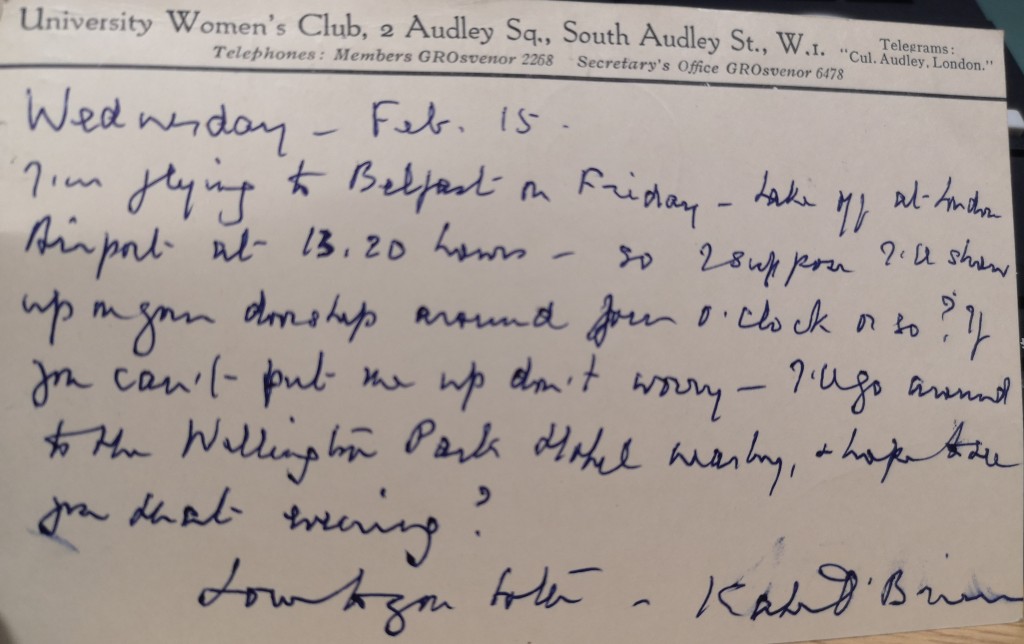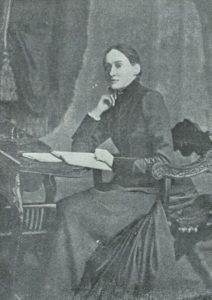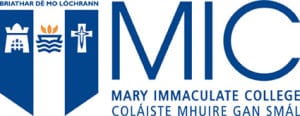Letters and the archive: Kate O Brien and Mary O Malley
Dr. Barry Houlihan
The correspondence of writers offers a significant insight into their personal as well as professional lives, revealing much about the networks in which they communicate and circulate ideas. Such archival sources can counter other public and more official sources and narratives including reviews, production histories, publication and publishers’ records, which all give voice to the public reception of a writer, though of course always within the context through which those works were received, distributed, or in some cases also censored and banned. Like other women novelists, playwrights, and writers of her generation, Kate O’Brien was a frequent target of such moral and literary censorship within modern Ireland.
A series of letters between Kate O’Brien and Mary O’Malley, founding director of the Lyric Theatre in Belfast, reveals a neglected exchange that may not be widely known among scholars or fans of O’Brien’s work. Held within the Lyric Theatre/O’Malley Archive at the Hardiman library, NUI Galway, the letters between O’Brien and O’Malley record an exchange over many years between two pioneers in literary form, theatrical production and publishing.

Mary O’Malley founded the Lyric Players theatre in 1950 along with her husband Pearse, in their Belfast home on the Lisburn Road, before moving some years later to Derryvolgie Avenue, and developed the Lyric from modest amateur beginnings into a major professional theatre company and arts centre in Belfast. The Lyric turned professional in 1968, the same year in which its new premises opened on the banks of the Lagan, where it still sits today. The Lyric remains the most prominent theatre venue in Northern Ireland.
O’Brien’s letters to O’Malley span the period when the Lyric was producing amateur theatre but moving towards becoming a fully professional entity. There are twelve manuscript letters and two postcards from O’Brien to O’Malley in that period, beginning on 11 April 1957 and ending on 29th August 1969.
The Lyric filled the role of an Arts Centre for Belfast (and Northern Ireland) by publishing a literary journal, Threshold, for over four decades, beginning in 1958 and ceasing publication in 1990, as well as an art gallery and music and drama school. The first letter in the exchange between the two women details O’Brien’s desire to contribute something to the Threshold, founded and edited by O’Malley, and published by the Lyric Theatre. Of publishing in the journal O’Brien writes:
I had wanted to write something especially good for you but could not [settle on? – something needed here] a suitable idea yet. So I send this short story – never published – but which B.B.C. thinks of returning . . . I think it is amusing. (11 April 1957)
The story was “A Bus from Tivoli”. On 7 May 1957, O’Brien wrote to O’Malley and thanked her for the inclusion of that story in Threshold and added her hopes to contribute to further issues of the journal.

Writing from her home at “The Fort”, at Roundstone, Co. Galway (1 December 1958), she praised the quality of contributions to Threshold, especially those by Padraic Colum, and again offered to contribute further work in the future. O’Brien finished the letter by adding she wished she had seen the recent production of The Voice of Shem, a stage-version of Joyce’s Finnegan’s Wake, which Mary Manning adapted for the stage and which was produced at the Lyric Theatre in 1958. Through “vain guessing”, she admitted she had been “trying to guess how on Earth Mary Manning worked on the thing”. By February of 1959, O’Malley had followed up with O’Brien seeking a promised second contribution for Threshold. This promise, at least, was not delivered on by O’Brien, with no further publication from her within Threshold that year.

Other letters are written by O’Brien at the address 24a, Steelis Road, N.W. 3, London, and offer apologies to O’Malley for not being able to accept a recent invitation to attend the Lyric as “my life is a great muddle at present, and a suddenness about a piece of work makes my chances of knocking off tomorrow, pretty poor” (7 Sept 1960). In November 1960, O’Brien asks to take up “the kind invitation” previously offered to stay with Mary and Pearse O’Malley in Belfast the following February as she is engaged to speak at the Alpha Club and in the same week to also speak at a P.E.N. event in Belfast.
Further to this venture, the Lyric, also opened an Art Gallery, which operated under the directorship of a renowned Austrian artist and designer, Alice Berger-Hammarshlag. O’Brien officiated at the opening of this gallery on 22 April 1963. The policy of the gallery stated it was to show works by artists of international stature and those of notable promise, whose work has not been seen in Belfast before; thus setting a standard of high artistic quality comparable with that of any cosmopolitan gallery anywhere. (Report of New Gallery, 1963, T4/970, Lyric Archive, NUIG)
In choosing O’Brien as the figure to launch such an ambitious artistic venture, O’Malley reinforced O’Brien’s standing as an international writer as much as an Irish writer. As the artistic figurehead of the launch, O’Brien was positioned as a public figure connected with the cosmopolitan and the idea of the European urban metropolis, where theatres, galleries and literary magazines regularly created spaces for artists to respond to the wider region and also to international artistic movements. O’Brien wrote of her feelings concerning art in Belfast in her book My Ireland, stating that Belfast became “indifferent to art” during its period of wealthy expanse. “This is indisputable and is written on its open, obstinate face”. She responded directly to this dearth of art in Belfast by supporting O’Malley and Berger-Hammarshlag on the Gallery venture.
The warmth of the letters also reveals O’Brien’s admiration for O’Malley. For instance, she wrote to express her delight that Queen’s University Belfast (Q.U.B.) had presented O’Malley with an honorary Master of Arts Degree in 1969. The Irish Times published a photograph of O’Malley as part of the academic procession at Q.U.B. on Monday 8 July 1969, and a day later O’Brien wrote to convey to O’Malley how much she felt that:
Queen’s University has done to honour itself! And greatly it does that in honouring you! I wish I’d been there to see the fine occasion. You’ll wear your academic honour with lightness and originality we can be sure. (9 July 1969).

Among the last letters from O’Brien was one written after she attended the official opening of the new Lyric Theatre in October 1968. She wrote again to O’Malley “offering all my wishes and congratulations – this is a great culmination of idealism, honour and hard work. May it flourish forever more . . . to startle and illumine old Belfast.” It is fitting O’Brien chose to use the words “startle” and “illumine” to describe the Lyric venture, as her own work did both these things in abundance.
This series of letters between Kate O’Brien and Mary O’Malley, written across two decades, provides important new insights into O’Brien’s wide network and into her connections to the artistic fabric of the city of Belfast.
The file (T4/867A) is part of the wider Lyric Theatre/O’Malley archive at the Hardiman Library, NUI Galway. The full archive catalogue is online here with an online archive exhibition; ‘Lyric50’ is online here.
Dr. Barry Houlihan is an archivist at NUI Galway, where he has worked on digital archive projects such as the Gate Theatre and Abbey theatre digital archives, and also on archives of Druid Theatre Company and of Galway International Arts Festival. Barry also teaches Theatre History and Archives, Digital Cultures, and Children’s Studies at NUI Galway and is the editor of the recent volume of essays: Navigating Ireland’s Theatre Archive: Theory, Practice, Performance.
Would you like to submit a blogpost? Check out our guidelines here or email Dr Deirdre Flynn.




Thank You, you really helped me when doing my research about her